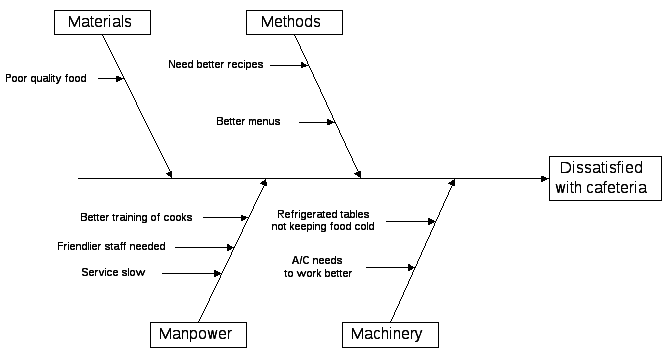
Problems
Management is concerned that workers create more product defects at the very beginning and end of a work shift than at other times of their eight hour workday. Construct a scatter diagram with the following data, collected last week. Is management justified in its belief?
-
Number of defects
Monday
Tuesday
Wednesday
Thursday
Friday
First hour at work
12
9
6
8
7
Second hour at work
6
5
3
4
5
Third hour at work
5
2
4
3
3
Fourth hour at work
4
0
5
2
3
Fifth hour at work
1
6
2
4
5
Sixth hour at work
4
3
3
2
1
Seventh hour at work
7
4
4
6
3
Eighth hour at work
5
7
8
5
9
Solution:

There is fairly convincing evidence that there are more defects in the first and last shift hours than at other times. (Tools of TQM, moderate) {AACSB: Analytic Skills}
Perform a Pareto analysis on the following information:
-
Reason for unsatisfying stay at hotel
Frequency
Unfriendly staff
6
Room not clean
2
Room not ready at check-in
3
No towels at pool
33
No blanket for pull-out sofa
4
Pool water too cold
3
Breakfast of poor quality
16
Elevator too slow or not working
23
Took too long to register
7
Bill incorrect
3
Total
100
Solution

(Tools of TQM, moderate) {AACSB: Analytic Skills}
Perform a Pareto analysis on the following information:
-
Reason for unsatisfying check-out at store
Frequency
Unfriendly cashier
27
Incorrect change
4
Cashier too slow
9
Price check
34
Poorly bagged merchandise
2
Slow receiving check approval
3
Solution

(Tools of TQM, moderate) {AACSB: Analytic Skills}
Construct a cause-and-effect diagram showing why a student might be dissatisfied with the cafeteria.
Solution: (Note that answers may vary considerably)

(Tools of TQM, Moderate) {AACSB: Analytic Skills}
Pretend that you have just come from a relative's wedding reception. It didn't turn out as well as it should have, and the bride's parents are pretty mad at how things turned out. Use the supplied template to construct a conventional cause-and-effect diagram. Identify twelve sources of defects for the issue "dissatisfied customer of wedding reception caterer." (Your dozen need not be exactly three per main cause, but should be a balanced treatment.) Categorize each cause onto a main cause. Provide brief support for each of your choices

Solution: Individual responses may vary considerably; some of the variation in responses comes from differing views of what is the caterer's realm of responsibility, compared to what might be assigned to a wedding planner instead. Material: not enough plates, glassware, utensils; prepared wrong dish; food was cold; ran out of food; food was "bad." Machinery: air conditioning/heating was broken; room was dirty; room too small; furniture poorly arranged; wedding "props" ugly or shopworn. Method: not on time; overcharged; not enough workers. Manpower: wait staff not properly attired; wait staff not speedy; wait staff not courteous. Responses should comment as necessary to show why a fault lies on a certain main branch; as an example, "cold food" might be interpreted as Method, not Material. (Tools of TQM, moderate) {AACSB: Analytic Skills}
A refrigeration and heating company—one that installs and repairs home central air and heating systems—has asked your advice on how to analyze their service quality. They have logged customer complaints. Here's a recent sampling. Use the supplied template to construct a conventional cause-and-effect diagram. Place each of the complaints onto a main cause; justify your choice with a brief comment as necessary. 1. "I was overcharged—your labor rates are too high." 2. "The repairman left trash where he was working." 3. "You weren't here when you said you would be. You should call when you must be late." 4. "Your repairman smoked in my house." 5. "The part you installed is not as good as the factory original." 6. "Your repairman was here for over two hours, but he wasn't taking his work seriously." 7. "You didn't tighten some of the fittings properly—the system's leaking." 8. "Your estimate of repair costs was WAY off." 9. "I called you to do an annual inspection, but you've done more—work that I didn't authorize." 10. "Your mechanic is just changing parts—he doesn't have a clue what's really wrong." 11. "Your bill has only a total—I wanted to see detail billing." 12. "Your testing equipment isn't very new—are you sure you've diagnosed the problem?" 13. "One of the workmen tracked mud into my living room."

Solution: Individual responses may vary. A typical set of responses might be Material: item 5. Method: items 1, 3, 8, 9, 11. Machinery: item 12; Manpower: items 2, 4, 6, 7, 10, 13. Items 8 and 11 could be manpower or method. (Tools of TQM, moderate) {AACSB: Analytic Skills}
